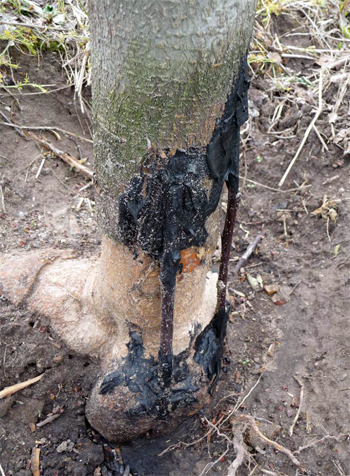Bridge grafting as a life-saving procedure for trees
Evaluate your situation and you may be able to save trees rather than replace them.
In the previous article referring to trees damaged by rodents, I talked about doing damage assessment and collecting the scionwood. The objective of this article is to address the next steps.
Saving the trees
Before anything else, make an assessment whether or not the trees are salvageable; is it going to be worth the time and the effort of trying to save them? This is greatly determined by the:
- Extent of damage
- Tree age
- Tree spacing.
For the young trees (1-2 year old) with severe damage (100 percent girdled trunk), cutting the trunk back below the injured area will save the tree. This will induce the regrowth and the newly developing shoot should be trained as a replacement tree.
The older trees need more involved “surgical” procedure known as - bridge grafting. As hopeful and good as this procedure is, it is not the answer for all trees. Stone fruits (cherry, peach, plum etc.) are very seldom successfully grafted. The other undesirable effect is in creating the opportunity for many disease (i.e. bacterial canker) and insect invasion (borer complex). Pome fruits (apples and pears) are in much better position. Both, young and old trees are easily grafted without too much trouble. For older trees, bridge grafting is an easy operation with high success rate.
Bridge grafting
To proceed with bridge grafting, following steps need to be done first:
- Collect the scionwood (in anticipation of the damage)
- Inspect the damage
- Prepare the area around the tree to be grafted
- Perform the grafting.
The first two steps should have been done along with the winter pruning or as soon as possible in early spring. It is essential to collect the scionwood from the dormant trees.
The last two steps are performed in May when the bark is “slippery” and is easily separated from the cambium without any damage to the bark or cambium. If the injury is right at the soil line or slightly below, one should dig down to the healthy part. It should be left exposed to the sun so it can worm-up and become “slippery”. This is done at least 10 days prior to grafting to insure high and good take/healing.
It is important not to rush the procedure. If the tree is not sufficiently “awake” the graft will not take. Tree sap or “juice” must be flowing for bark to “slip” easy!
What makes a good scionwood?
- One year old growth at 3/8” in diameter. Water sprouts work well.
- Straight branches 15-18” long.
- Wood from healthy trees.
- Wood from disease (fire blight) tolerant trees.
- Cultivars for apples: Red delicious, Empire, Spy ...
- Cultivars for pears: Old Home, Seckel, Kieffer ...
Bridge grafting - step by step
- Clean up the wound and trim the bark to an even cut.
- Prepare a scion-wood by cutting it at 3” longer than the length of the wound .
- Make a wedge cut on both ends of the scion-wood.
- Make an inlay cut into the bark from the edges of the wound, approximately 2” long and as wide as the scion-wood.
- Remove the bark, so the healthy wood is exposed.
- Place the wedged scion-wood into the slit and affix it with the nails.
- Do the same with the other end.
- Make sure that the scion-wood is at the slight bow. That will insure flexibility and better cambial contact.
- Scion-wood should be placed every 3-4” apart all around.
- Upon completion, cover graft unions with the grafting compound or wax to preserve moisture and prevent drying out.

Completely girdled tree saved by the bridge grafts. Photo credit: M. Danilovich



 Print
Print Email
Email



